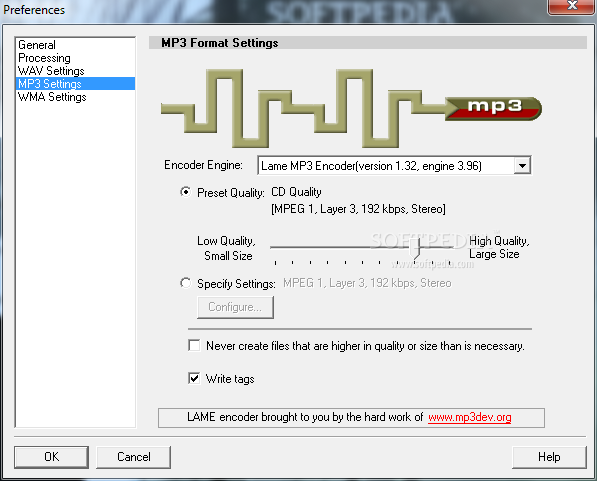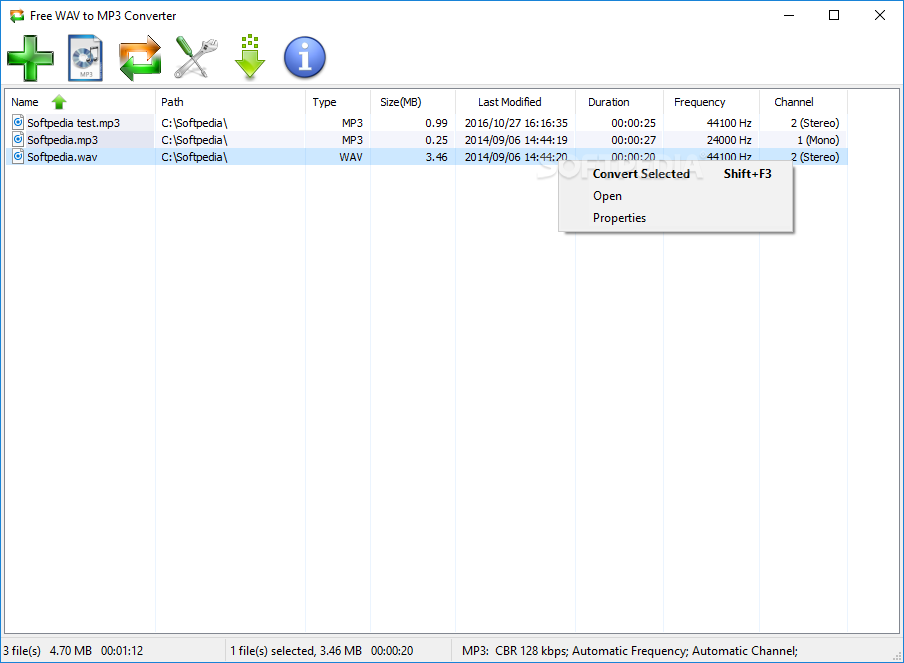
- Wave mp3 encoder code#
- Wave mp3 encoder windows#
Wave mp3 encoder code#
The small code for capturing data as uncompressed wav is located separately in which comes in at just 2.6 KB minified and 1 KB gzipped. Also, keep in mind that Vorbis is mostly aimed at compressing music and audio in general, it’s not aimed at compressing speech like the way Speex is. The Vorbis encoder can encode mono or stereo sound and you can configure the bitrate from 45kb/s to 500kb/s. That’s 2 HTTP requests and 209KB in total when gzipped.
.mem 553 KB minified and 114KB gzipped. The current implementation supports LAME CBR encoding only, no VBR (variable bit rate). The MP3 encoder is locked at recording 2 channels but you can configure the bitrate from 64 to 320. That’s 2 HTTP requests and 126KB in total when gzipped. These libraries are loaded and used as Web Workers which prevents the browser tab from becoming unresponsive while the audio encoding is underway.Įven though the main JS file comes in at just 3.6KB when minified (and 1.21 KB when gzipped) unless you’re recording to wav, you do have to make extra HTTP requests and load the external libraries, and these libraries are quite big: Since JavaScript is slower than native code you should expect your encoding times to be higher. These libraries are Java Script versions of the popular LAME mp3 encoder and libogg/ libvorbis encoders obtained by compiling the original C code using Empscripten as (the asm.js subset of) JavaScript. WebAudioRecorder.js uses external JavaScript libraries to convert the raw audio to mp3 and Vorbis. When used in conjunction with getUserMedia() it can record the audio from the user’s microphone or webcam. WebAudioRecorder.js is a JavaScript library written in 2015 by higuma that can record audio and encode to common formats directly in the browser. The project is available on GitHub, link at the bottom, live demo here. There are 2 demos available for WebAudioRecorder ( the main one linked from GitHub that’s not working and a functioning one) but they’re fairly complex implementations and thus hard to get started with. We’ll be building a simple demo to help you get started with the library. In this blog post, we’ll cover using WebAudioRecorder.js to record mp3, vorbis and wav audio on your website. There are various tricks you can do to make automatic encoding happen but the reality is you can really use it much of the time as you have too many disparate file formats.This is the 2nd post in our new recording audio in HTML5 series. I'm not sure if I quite get the picture of what you are saying in the last paragraph. Anyway enough of that rant, you can rant more directly than I can You would think that if the intention was only to use the filter privately then it wouldn't be publically registered, but apparently the WMP team missed that memo and instead decided to essentially break every DirectShow audio application out there by letting them "think" they could use it. It seems that on Vista the filter is publicly registered but not publically useable any longer. Wave mp3 encoder windows#
There is an MP3 encoder and decoder on every machine that has Windows Media Player installed, whether you can actually use it is another issue entirely. The creation of output profiles is a little bit fiddly but easy enough once you've done a couple. If you are working with PCM sources I don't think it is any harder than anything else. Then a solution like the async source might make sense, although I wish there was the inverse of RenderFile(), i.e.: here's a file, now set up a whole filtergraph to render _to_ a file of the same format, so I didn't have to think about creating and connecting the mp3 encoder (not having to think about codecs is, to me, 90% of the magic of DirectShow).ĭan using the Format SDK directly gives you a lot tighter control.



I'm currently punting on encoding mp3 until I figure out what codecs I can reasonably expect to be available on users' machines. Then I set the reference clock for the graph to "null" so it will just plow through the whole file as fast as it can.įor _encoding_, I ended up using the media format SDK to write wma files (a big pain to configure but very powerful once it works, much like DirectShow.). FYI for _decoding_, I ended up using a similar approach to what you suggested: calling RenderFile (without worrying about file type), then pulling off the renderer and tacking on a sample grabber, any necessary sample converters (which Connect() adds automatically for me), and a null renderer.







 0 kommentar(er)
0 kommentar(er)
